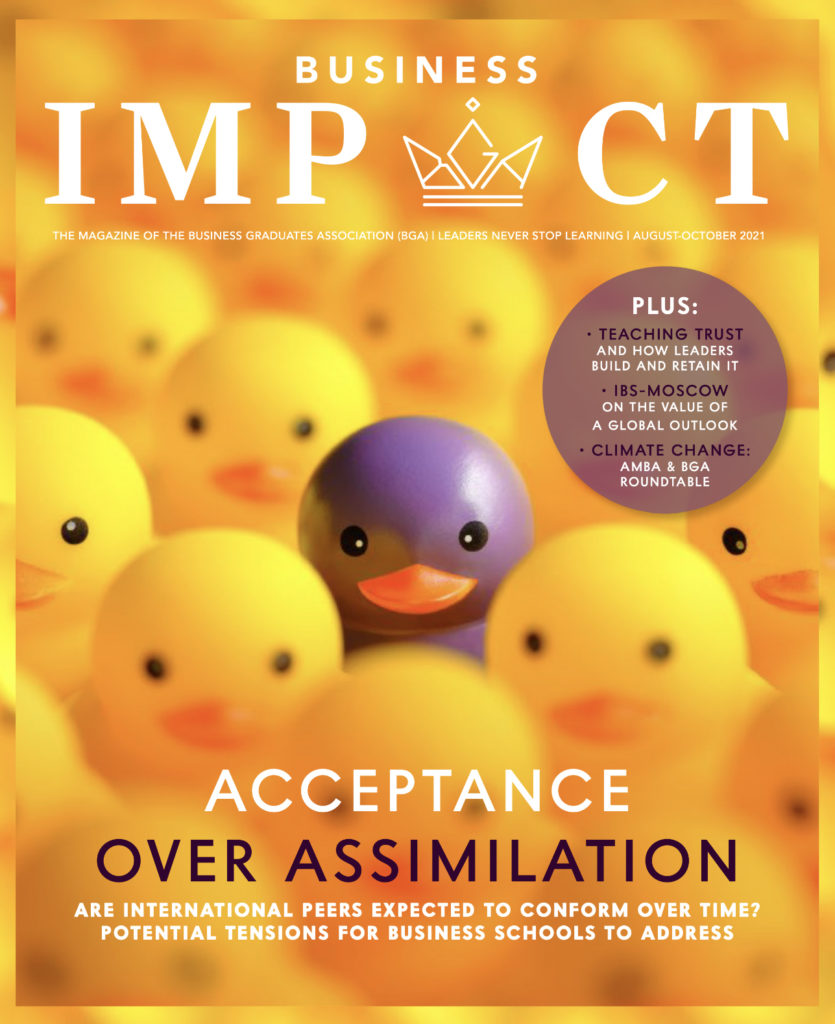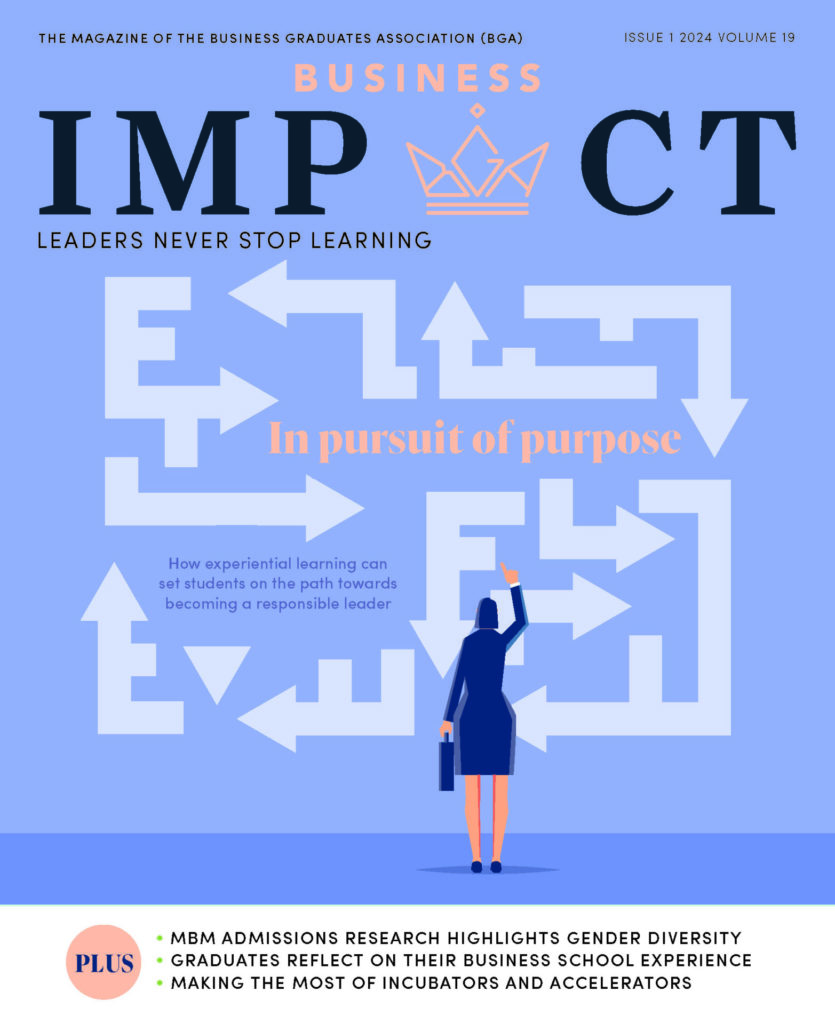Moving to a new country for one’s studies or work can be an exhilarating, enriching and often daunting experience. The typical international student has a lot on their plate. On top of their coursework, they might have to become increasingly fluent in another language while also forging new connections in a country with new norms and expectations. International students studying on management or MBA programmes are often also faced with the stresses associated with gaining valuable, but demanding, international business experience and securing highly competitive jobs in their chosen country.
When you couple moving to a new country with finding a new job, expats might wonder how they can navigate these changes successfully. When starting at a new university or job, international students may feel pressure to conform to the expectations of new colleagues and employers. A real worry may emerge that if they don’t assimilate, they may experience bias and ostracism. This pressure to conform may be especially challenging for international students who strongly identify with their country of origin, and who are reluctant to sacrifice their norms and values for the sake of fitting in.
The tension that international workers feel these days echoes a common challenge for contemporary organisations and universities. These institutions, now recognising the value of diversity and inclusion, often want to embrace difference among employees. Tolerance of difference allows each employee to bring unique and valuable perspectives to the workplace, enhancing innovation and progress.
However, we know tolerance isn’t always guaranteed, and that many would prefer it if all minority groups assimilated to the majority’s way of doing things. Some degree of assimilation will always be necessary just so organisations can function, as a common language and way of doing things is essential for coordination and efficiency. How then, can we collectively ensure that students and workers from international backgrounds are all able to succeed and contribute, while also sparing them the pressure to give up their valuable perspectives and sense of self?
Understanding where majority group intolerance comes from
Understanding how we can help alleviate the pressures on immigrants to assimilate requires an understanding of who is generating these pressures – i.e. the native-born majority group. Throughout history, there is an abundance of examples of majority groups treating minorities poorly and, despite some progress in recent years, this is not a phenomenon that we’ve escaped.
The majority group’s desire for minority groups to conform to the majority’s norms is rooted in the fundamental dynamics of social groups. In diverse settings, the majority group typically enjoys the privileged position of representing the broader category in which they reside. For example, when people think of what it means to be a citizen of a given country, they typically think of members of the native-born majority group. This means that the majority group sets the norms to which other groups are expected to conform. Being the group that is most strongly associated with their broader context affords members of majority groups a reliable sense of inclusion and comfort. In academic terminology, we would say that majority groups are ‘prototypical’ of their broader contexts.
There are many examples of prototypicality in action. For example, in historically male-dominated professions like firefighting, men are prototypical, whereas women are not. That is, when asked to think of a firefighter, most people will think of a man. Within firefighting, stereotypically masculine traits (such as strength, stamina and decisiveness) are often privileged over stereotypically feminine one (such as compassion and patience). All of this means that women have a harder time being recognised as fitting the mould of a ‘true firefighter’. This doesn’t mean that individual men can’t also struggle to fit in, only that their gender is unlikely to be the source of these challenges in the same way that it is for women.
International students and immigrants often face similar barriers as a result of their non-prototypicality. People who are native to their country of residence don’t have to worry whether their nationality will put them at a disadvantage in the same way that immigrants often do.
Expectations of assimilation shape bias
Compounding the disadvantage that immigrants may face given their non-prototypicality, my research highlights how the senses of group prototypicality can actually drive increases in bias against minority groups, such as international students.
The sense of security and comfort that prototypicality affords can quickly dissipate when change is felt to be imminent. If established majority groups notice an increase in the representation of minority groups, they may feel that their prototypicality, their very sense of belonging and the sense of comfort connected to it, is threatened. The majority group may feel like they will soon be the ones who will have to worry about fitting in. My research shows that this sense of ‘prototypicality threat’ – the fear of losing prototypicality – is a powerful driver of dominant groups’ resistance to diversity.
My own research has also shown that feelings of threat are deeply influenced by prospective beliefs about whether intergroup difference will grow or shrink over time. Members of majority groups are most susceptible to prototypicality threat when they believe that minority groups are unwilling or unable to assimilate over time. In contrast, however, members of majority groups who believe that minority groups will assimilate do not experience this threat. That is, members of dominant groups are willing to tolerate some difference in the present, but only if they believe it will diminish over time.
Increasing tolerance
In light of this research, one might think it would be best for international students and immigrants to always assimilate as the best way to avoid conflict when interacting with members of their new country.
Although my research shows that this would, indeed, reduce the discomfort felt by the native-born majority, we strongly recommend that individuals and organisations avoid this approach. As noted, some degree of assimilation will be necessary, but total assimilation will undermine diversity and inclusion goals and may come at great psychological cost to immigrants who feel attached to their identities. Furthermore, members of the majority group may still feel threatened by immigrants in other ways, like perceptions of increased competition over jobs and resources.
Rather than sacrificing diversity to placate an anxious and privileged majority, efforts should be directed at increasing tolerance. Reminding members of the majority group that their ‘prototypicality’ is incidental, and that institutions are perpetually redefining themselves to better fit in a changing global market may be one way to reduce majority group resistance to change. Emphasising the value of diversity and inclusion for everyone may be another way to encourage members of majority groups to overcome their discomfort in welcoming international peers who retain, rather than shed, their unique backgrounds.
Efforts to encourage inclusion will also need to be embraced and enacted by leadership. For immigrants, this may mean drawing attention to the often-subtle peer pressure that makes someone feel like their sense of belonging is conditional on assimilating. Employee resource groups where members of minority groups can talk about their experiences with those in a similar position can be beneficial as well. Mentorship programmes and town-hall meetings can ensure that communication is maintained and that any latent tensions are addressed before they lead to serious conflict. To ensure that the burden of responsibility does not fall entirely on new starters, leadership should act quickly to create these structures if they do not exist already.
None of the difficulties I’ve mentioned should dissuade anyone from choosing to study or work in another country. I genuinely believe that the experience offers unrivalled opportunities to grow knowledge, capabilities and cultural awareness. I also don’t want to suggest that intergroup conflict is inevitable, as many people will have wholly positive experiences studying or working abroad. However, given how commonplace intolerance still is, institutions should be ready to anticipate and address tensions that may emerge. I hope that international students moving on from their management programmes also remember the uniquely different perspective that they bring to organisations and the inherent added value that provides. It should not be forgotten, because it cannot be replaced.
Recommendations for leaders in business schools and beyond
Here are three things that leaders in organisations can do to increase appreciation for international students and workers:
1) Prepare for some discomfort from the majority group
All people naturally get comfortable doing things in certain ways over time. This is especially true when they feel like their own way of doing things is the way that the majority of people have always done them. Introducing different and new perspectives can sometimes lead to disagreement and tension from those who would prefer that others assimilate to them, rather than the other way around. Business leaders and managers should be prepared for the possibility of complaints from members of majority groups and take steps to ensure that these unsettled individuals don’t take out their discomfort directly on the newcomers.
2) Carefully define what you value
The traits we collectively value in our institutions and organisations often inadvertently reflect the traits already associated with the majority group. If organisations reinforce this in one way or another, they may unwittingly legitimise the idea that the majority group is valued more than newcomers. Highlighting the value of the traits associated with international students and workers can both increase tolerance and dispel the notion that the majority group’s way of doing things will always be the best. Emphasising the importance of diversity and inclusion, and making a public commitment to these goals, can also help remind hesitant individuals that their organisation wants them to embrace difference.
3) Give international students and workers a way to speak up
Belonging to a minority group can be an isolating experience, so organisations should proactively provide opportunities and spaces for international students and workers to gather together and talk about their shared experiences. Direct communication with leadership can help ensure that challenges are being identified and addressed.









